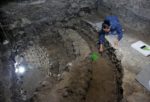 The Aztec tzompantli (skull rack) discovered in the Templo Mayor complex in downtown Mexico City two years ago has proven to be on an even vaster scale than first realized. Archaeologists with the National Institute of Anthropology and History (INAH) unearthed the tower of skulls six feet under the floor of a colonial-era house west of the Templo Mayor. At the center of a rectangular platform 34 meters (111.5 feet) long and 12 meters (40 feet) wide, they found a circular structure six meters (20 feet) in diameter made of skulls mortared together with a combination of lime, sand and volcanic gravel.
The Aztec tzompantli (skull rack) discovered in the Templo Mayor complex in downtown Mexico City two years ago has proven to be on an even vaster scale than first realized. Archaeologists with the National Institute of Anthropology and History (INAH) unearthed the tower of skulls six feet under the floor of a colonial-era house west of the Templo Mayor. At the center of a rectangular platform 34 meters (111.5 feet) long and 12 meters (40 feet) wide, they found a circular structure six meters (20 feet) in diameter made of skulls mortared together with a combination of lime, sand and volcanic gravel.
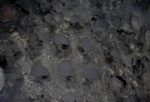 Tzompantli were used by the Aztecs to display the heads of the sacrificed, usually warriors captured in battle. The skulls were pierced from temple to temple and threaded onto wooden stakes that were mounted onto vertical posts like a grisly abacus. Pierced skulls and the remains of stakes have been found before, but they’ve been very modest in size and there was no permanent, mortared structure in place studded with the skulls of sacrificial victims.
Tzompantli were used by the Aztecs to display the heads of the sacrificed, usually warriors captured in battle. The skulls were pierced from temple to temple and threaded onto wooden stakes that were mounted onto vertical posts like a grisly abacus. Pierced skulls and the remains of stakes have been found before, but they’ve been very modest in size and there was no permanent, mortared structure in place studded with the skulls of sacrificial victims.
 The Templo Mayor skull tower is therefore unique in the archaeological record. Holes through the parietal bones of the skulls’ indicate that as unusual as it is, the tower was part of the life cycle (death cycle?) of the Huey Tzompantli, a huge skull display in the city center that horrified even the Spanish conquistadors, no strangers to mass slaughter. One of Cortes’ soldiers, Andres de Tapia, described the Huey Tzompantli as displaying thousands of skulls at a time. Archaeologists believe the tower was the stage two, the final disposition of the heads after they’d been exposed to the public on the Tzompantli array. The defleshed heads were then mortared into the tower, all of the skulls positioned to face the inside the circle.
The Templo Mayor skull tower is therefore unique in the archaeological record. Holes through the parietal bones of the skulls’ indicate that as unusual as it is, the tower was part of the life cycle (death cycle?) of the Huey Tzompantli, a huge skull display in the city center that horrified even the Spanish conquistadors, no strangers to mass slaughter. One of Cortes’ soldiers, Andres de Tapia, described the Huey Tzompantli as displaying thousands of skulls at a time. Archaeologists believe the tower was the stage two, the final disposition of the heads after they’d been exposed to the public on the Tzompantli array. The defleshed heads were then mortared into the tower, all of the skulls positioned to face the inside the circle.
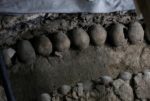 When the discovery was first reported in August 2015, archaeologists had found 35 skulls. Now that number is now 676, and the excavation isn’t over yet. Archaeologists fully expect the final tally will reach into the thousands, just like de Tapia said. The sheer scale of the tower is striking enough, but the inclusion of skulls of adult women, youths and small children took archaeologists by surprise.
When the discovery was first reported in August 2015, archaeologists had found 35 skulls. Now that number is now 676, and the excavation isn’t over yet. Archaeologists fully expect the final tally will reach into the thousands, just like de Tapia said. The sheer scale of the tower is striking enough, but the inclusion of skulls of adult women, youths and small children took archaeologists by surprise.
Historians relate how the severed heads of captured warriors adorned tzompantli, or skull racks, found in a number of Mesoamerican cultures before the Spanish conquest.
But the archaeological dig in the bowels of old Mexico City that began in 2015 suggests that picture was not complete.
“We were expecting just men, obviously young men, as warriors would be, and the thing about the women and children is that you’d think they wouldn’t be going to war,” said Rodrigo Bolanos, a biological anthropologist investigating the find.
“Something is happening that we have no record of, and this is really new, a first in the Huey Tzompantli,” he added.
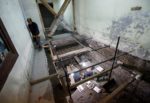 The Templo Mayor was one of the most important temples in the sacred precinct of Tenochtitlan, the capital of the Aztec Empire which became Mexico City after the Spanish conquest. The tower is now located next to the Metropolitan Cathedral built over the Templo Mayor by the Spanish. When it was built during Stage VI of the construction of the Templo Mayor (between 1486 and 1502), it was on the corner of the chapel of Huitzilopochtli, Aztec god of the sun, war and human sacrifice, a fitting location for a tower of skulls.
The Templo Mayor was one of the most important temples in the sacred precinct of Tenochtitlan, the capital of the Aztec Empire which became Mexico City after the Spanish conquest. The tower is now located next to the Metropolitan Cathedral built over the Templo Mayor by the Spanish. When it was built during Stage VI of the construction of the Templo Mayor (between 1486 and 1502), it was on the corner of the chapel of Huitzilopochtli, Aztec god of the sun, war and human sacrifice, a fitting location for a tower of skulls.
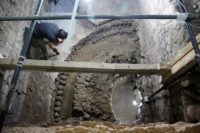
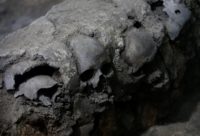
Few are in the know that, influenced by the Tenochtitlan based management consulting firm ‘Cranial, Skully & Partner’, the aztec undertaking industry of the 1480ies underwent massive restructuring: Thus, instead of primary -so called- “burials”, plus secondary ones of disarticulated bones, dying itself and the latter were recombined into one single business process with temple construction.
The ‘Sedlec Ossuary’ in Kutná Hora -to refer to another example- features bones of 40000 individuals, of which 10K ‘sets’ are part of a special ‘installation’, there is the Ћеле Кула in Serbia from 1908 (952 skulls in 14 rows) and in France, 2000 years ago, skulls were already construction material. They even had ‘racks’ with slain bodies in place, i.e. minus the heads (e.g. in Ribemont-sur-Ancre).
— :skull: – :ohnoes: – :skull: – :skull: – :ohnoes: —
Just a question. I have not received any auto-emails from Word-Press (or whoever) from your site since you updated everything two weeks ago. Do you know how to fix that?